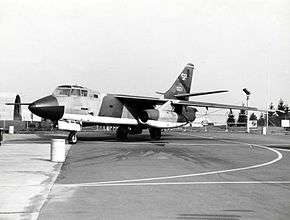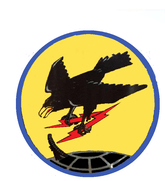39th Tactical Electronic Warfare Squadron
The 39th Tactical Electronic Warfare Squadron is an inactive United States Air Force unit. It was last assigned to the 52d Tactical Fighter Wing at Spangdahlem Air Base, Germany, where it was inactivated in January 1973.
39th Tactical Electronic Warfare Squadron
 | |
|---|---|
 39th Tactical Electronic Warfare Squadron EB-66E | |
| Active | 1943–1945; 1947–1949; 1969–1973 |
| Country | |
| Branch | |
| Role | Electronic Warfare |
| Engagements | Mediterranean Theater of Operations European Theater of Operations |
| Decorations | Distinguished Unit Citation |
| Insignia | |
| 39th Tactical Electronic Warfare Squadron emblem |  |
| 39 TEWS tail code 1969–1973[1] | SP |
| World War II tail markings after May 1944[2] | Black diamond above, bottom of tail white |
| World War II tail markings before May 1944[2] | Black diamond on white circle above, black number 1 in white circle below. |
The first predecessor of the squadron was the 739th Bombardment Squadron, which was activated in June 1943. After training in the United States with the Consolidated B-24 Liberator, the 739th deployed to the Mediterranean Theater of Operations, participating in the strategic bombing campaign against Germany. It earned two Distinguished Unit Citations for its combat operations. Following V-E Day, the squadron returned to the United States for conversion as a very heavy bomber unit, but was inactivated instead.
The 39th was activated at Spangdahlem in 1969. The two squadrons were consolidated in 1985, but have not been active since then.
History
World War II

The squadron was first organized at Alamogordo Army Air Field, New Mexico on 1 June 1943 as one of the four squadrons of the 454th Bombardment Group. It trained with Consolidated B-24 Liberator bombers. After completing training, it left for the Mediterranean Theater of Operations on 8 December 1943.[3][4]
The squadron arrived in Italy in January 1944, settling in at its combat station, San Giovanni Airfield, by the end of the month. Its primary focus was on long range bombing missions against industrial targets such as enemy oil refineries and munitions and aircraft factories. It struck transportation targets including harbors and airfields in Italy, France, Germany, Austria, Czechoslovakia, Hungary, Yugoslavia, Greece and Rumania The squadron received a Distinguished Unit Citation (DUC) for a raid on an airfield at Bad Voslau, Austria on 12 April 1944. The squadron earned a second DUC during an attack on a steel plant at Linz, Austria, as the 454th Group led its wing through determined opposition.[4]
The squadron also flew air support and air interdiction missions against marshalling yards, troop concentrations and rail lines for Operation Strangle. The squadron participated in the drive to Rome; Operation Dragoon, the invasion of southern France; and Operation Grapeshot, the Spring 1945 offensive in Northern Italy.[4]
The squadron left Italy in July 1945 and reformed at Sioux Falls Army Air Field, South Dakota the following month. It was redesignated as a very heavy bombardment squadron in anticipation of training and redeployment to the Pacific, but with the Japanese surrender, it was inactivated in October.[3]
Air Force Reserve
The 739th Bombardment Squadron was reactivated as a reserve unit under Air Defense Command (ADC) at McChord Field, Washington in April 1947 as a Boeing B-29 Superfortress unit, where its training was supervised by the 406th AAF Base Unit (later the 2345th Air Force Reserve Training Center).[5] However, the squadron does not appear to have been fully staffed or equipped with operational aircraft while a reserve unit.[6] In 1948 Continental Air Command assumed responsibility for managing reserve and Air National Guard units from ADC.[7] President Truman's reduced 1949 defense budget required reductions in the number of units in the Air Force.[8] Continental Air Command also reorganized its reserve units under the wing base organization system in June 1949. The squadron was inactivated and its personnel and equipment were transferred to elements of the 302d Troop Carrier Wing, which was activated simultaneously.[9][10]
Cold War
The 39th Tactical Electronic Warfare Squadron was activated in April 1969 at Spangdahlem Air Base Germany in an effort to restore an electronic warfare capability to United States Air Forces Europe (USAFE). It was planned to equip the squadron with Douglas EB-66 Destroyers, but all of USAFE's EB-66s had deployed to Southeast Asia to provide jamming support for the Viet Nam War. As a result, the squadron was initially equipped with the less capable Martin EB-57 Canberra. Shortly after activation, it became possible to equip the unit with sixteen EB-66s.[11] The squadron continued its mission at Spangdahlem until ceasing operations in December 1972. It was inactivated in January 1973 as the EB-66 was withdrawn from the Air Force inventory.[12][13]
The 739th Bombardment Squadron and the 39th Tactical Electronic Warfare Squadron were consolidated into a single unit in September 1985.[14]
Lineage
739th Bombardment Squadron
- Constituted as the 739th Bombardment Squadron (Heavy) on 14 May 1943
- Activated on 1 June 1943
- Redesignated 739th Bombardment Squadron, Heavy c. 1944
- Redesignated 739th Bombardment Squadron, Very Heavy on 5 August 1945
- Inactivated on 17 October 1945
- Activated in the reserve on 16 August 1947
- Inactivated on 27 June 1949[15]
- Consolidated on 19 September 1985 with the 39th Tactical Electronic Warfare Squadron as the 39th Tactical Electronic Warfare Squadron[14]
39th Tactical Electronic Warfare Squadron
- Constituted as the 39th Tactical Electronic Warfare Squadron on 18 March 1969
- Activated on 1 April 1969
- Inactivated on 1 January 1973
- Consolidated on 19 September 1985 with the 739th Bombardment Squadron[14]
Assignments
Stations
- Alamogordo Army Air Field, New Mexico 1 June 1943
- Davis–Monthan Field, Arizona, 1 July 1943
- McCook Army Air Field, Nebraska, 30 July 1943
- Charleston Army Air Field, South Carolina 3 October 1943 – December 1943
- San Giovanni Airfield, Italy, 21 January 1944 – July 1945
- Sioux Falls Army Air Field, South Dakota, 1 August 1945
- Pyote Army Air Field, Texas 17 August 1945 – 17 October 1945
- McChord Field (later McChord Air Force Base), Washington, 27 April 1947 – 27 June 1949[15]
- Spangdahlem Air Base, Germany, 1 April 1969 – 1 January 1973[17]
Aircraft
Awards and campaigns
| Award streamer | Award | Dates | Notes |
|---|---|---|---|
| Distinguished Unit Citation | 12 April 1944 | 739th Bombardment Squadron, Bad Voslau, Austria[3] | |
| Distinguished Unit Citation | 25 July 1944 | 739th Bombardment Squadron, Linz, Austria[3] |
| Campaign Streamer | Campaign | Dates | Notes |
|---|---|---|---|
| Air Combat, EAME Theater | January 1944-11 May 1945 | 739th Bombardment Squadron[3] | |
| Air Offensive, Europe | January 1944-5 June 1944 | 739th Bombardment Squadron[3] | |
| Rome-Arno | 22 January 1944 – 9 September 1944 | 739th Bombardment Squadron[3] | |
| Normandy | 6 June 1944 – 24 July 1944 | 739th Bombardment Squadron[3] | |
| Northern France | 25 July 1944 – 14 September 1944 | 739th Bombardment Squadron[3] | |
| Southern France | 15 August 1944 – 14 September 1944 | 739th Bombardment Squadron[3] | |
| North Apennines | 10 September 1944 – 4 April 1945 | 739th Bombardment Squadron[3] | |
| Rhineland | 15 September 1944 – 21 March 1945 | 739th Bombardment Squadron[3] | |
| Central Europe | 22 March 1944 – 21 May 1945 | 739th Bombardment Squadron[3] | |
| Po Valley | 3 April 1945 – 8 May 1945 | 739th Bombardment Squadron[3] |
See also
References
Notes
- See photo of squadron EB-66
- Watkins, p. 99
- Maurer, Combat Squadrons, p. 729
- Maurer, Combat Units, p. 329
- "Abstract, History 2545 AF Reserve Training Center, Jul-Dec 1948". Air Force History Index. Retrieved 29 June 2020.
- See Maurer, Combat Squadrons, p. 729 (listing no aircraft for the period 1947–1949)
- "Abstract, Mission Project Closeup, Continental Air Command". Air Force History Index. 27 December 1961. Retrieved 24 March 2014.
- Knaack, p. 25
- Ravenstein, pp. 147–149
- See Mueller, p. 394
- Knaack, pp. 448–449
- Knaack, pp. 449–450
- Ravenstein, p. 85
- Department of the Air Force/MPM Letter 662q, 19 September 85, Subject: Reconstitution, Redesignation, and Consolidation of Selected Air Force Tactical Squadrons
- 739th Bombardment Squadron lineage, including assignments and stations in Maurer, Combat Squadrons, p. 729.
- Ravenstein, pp. 63–64
- Fletcher, p. 170
Bibliography
![]()
- Fletcher, Harry R (1993). Air Force Bases , Vol. II, Air Bases Outside the United States of America (PDF). Washington, DC: Center for Air Force History. ISBN 0-912799-53-6. Retrieved 17 December 2016.
- Knaack, Marcelle Size (1978). Encyclopedia of US Air Force Aircraft and Missile Systems (PDF). Vol. 2, Post-World War II Bombers 1945–1973. Washington, DC: Office of Air Force History. ISBN 0-912799-59-5. Retrieved 17 December 2016.
- Maurer, Maurer, ed. (1983) [1961]. Air Force Combat Units of World War II (PDF) (reprint ed.). Washington, DC: Office of Air Force History. ISBN 0-912799-02-1. LCCN 61060979.
- Maurer, Maurer, ed. (1982) [1969]. Combat Squadrons of the Air Force, World War II (PDF) (reprint ed.). Washington, DC: Office of Air Force History. ISBN 0-405-12194-6. LCCN 70605402. OCLC 72556.
- Mueller, Robert (1989). Air Force Bases, Vol. I, Active Air Force Bases Within the United States of America on 17 September 1982 (PDF). Washington, DC: Office of Air Force History. ISBN 0-912799-53-6.
- Ravenstein, Charles A. Air Force Combat Wings, Lineage & Honors Histories 1947–1977. Washington, DC: Office of Air Force History. ISBN 0-912799-12-9.
- Watkins, Robert A. (2013). Insignia and Aircraft Markings of the U.S. Army Air Force in World War II. Volume V, Pacific Theater of Operations. Atglen, PA: Shiffer Publishing, Ltd. ISBN 978-0-7643-4346-9.
Further reading
- Cantwell, Gerald T. (1997). Citizen Airmen: a History of the Air Force Reserve, 1946-1994. Washington, D.C.: Air Force History and Museums Program. ISBN 0-16049-269-6.